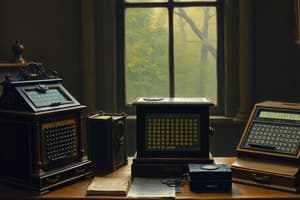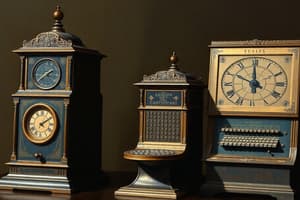Podcast
Questions and Answers
Who invented the mechanical calculator known as Pascaline?
Who invented the mechanical calculator known as Pascaline?
- Blaise Pascal (correct)
- Ada Lovelace
- Charles Babbage
- John Napier
Which machine, developed by Charles Babbage, was designed to be steam-powered and fully automatic?
Which machine, developed by Charles Babbage, was designed to be steam-powered and fully automatic?
- ENIAC
- Difference Engine (correct)
- Turing Machine
- Harvard Mark I
What breakthrough concept did Ada Lovelace suggest for data storage?
What breakthrough concept did Ada Lovelace suggest for data storage?
- Decimal system
- Hexadecimal system
- Binary system (correct)
- Octal system
What was Hollerith's Tabulator primarily used for?
What was Hollerith's Tabulator primarily used for?
What electronic device did John Ambrose Fleming develop in 1904 that characterized the first generation of computers?
What electronic device did John Ambrose Fleming develop in 1904 that characterized the first generation of computers?
What was the primary function of the Turing Machine developed by Alan Turing?
What was the primary function of the Turing Machine developed by Alan Turing?
What capability did the Harvard Mark I possess that was significant for its time?
What capability did the Harvard Mark I possess that was significant for its time?
What was one of the notable features of the ENIAC machine developed by Mauchly and Eckert?
What was one of the notable features of the ENIAC machine developed by Mauchly and Eckert?
What was the significance of the UNIVAC I in computing history?
What was the significance of the UNIVAC I in computing history?
Which programming language was developed by John Backus in the 1950s?
Which programming language was developed by John Backus in the 1950s?
Which of the following computers was developed first in the timeline provided?
Which of the following computers was developed first in the timeline provided?
What innovation did the IBM System/360 series introduce?
What innovation did the IBM System/360 series introduce?
What role did Dr. Grace Murray Hopper play in programming language development?
What role did Dr. Grace Murray Hopper play in programming language development?
When was the Internet started according to the timeline?
When was the Internet started according to the timeline?
Which microprocessor was the first to be developed by Intel?
Which microprocessor was the first to be developed by Intel?
Which important feature was introduced with the Apple Macintosh computer in 1984?
Which important feature was introduced with the Apple Macintosh computer in 1984?
Flashcards are hidden until you start studying
Study Notes
Early Computing Devices
- Napier's Bones (1600s) - John Napier invented a manual calculating device for multiplication and division.
- Pascaline (1642) - Blaise Pascal created a mechanical calculator that could add and subtract directly and multiply and divide through repetition.
- Difference Engine (1812) - Charles Babbage, often called the "father of the computer", designed a steam-powered, fully automatic machine that was controlled by a fixed instruction program.
- Analytical Engine (1840s) - Ada Lovelace, known as the world's first computer programmer, wrote the first algorithm intended for the Analytical Engine. She advocated for the use of a binary system for storage instead of a decimal system.
- Boolean Logic (1850s) - George Boole developed Boolean logic, which later became crucial for computer circuitry design.
- Hollerith's Tabulator (1890s) - Herman Hollerith introduced an electromechanical, punched-card data-processing machine that was used for the 1890 U.S. census. His company, which marketed the machine, eventually grew into International Business Machines (IBM).
The Rise of Electronic Computing
- Vacuum Tube (1906) - John Ambrose Fleming invented the vacuum tube, an electronic device that controls electric current flow in a vacuum. It became an important component in technologies like televisions and radios.
- Turing Machine (1943) - Alan Turing, a British mathematician, developed a hypothetical device that could conduct logical operations and read and write, influencing the development of modern computers.
- Harvard Mark I - Howard Aiken, with IBM engineers, constructed a large automatic digital sequence-controlled computer. The Harvard Mark I was designed to handle arithmetic operations, logarithms, and trigonometric functions.
- ENIAC (Electronic Numerical Integrator and Calculator) - John Mauchly and J. Presper Eckert Jr. built the ENIAC, which utilized 18,000 vacuum tubes, punch-card input, and weighed 30 tons.
Early Commercial Computing
- UNIVAC I (1951) - Mauchly and Eckert created the first commercially available computer, specifically designed for business data-processing applications.
- UNIVAC I Compiler (1950s) - Grace Murray Hopper was instrumental in creating the UNIVAC I compiler.
- FORTRAN (Formula Translator) (1957) - John Backus, an IBM engineer, developed the FORTRAN programming language.
Key Developments and Innovations
- IBM System/360 (1960s) - Gene Amdahl designed the IBM System/360 series of mainframe computers, the first general-purpose digital computers to use integrated circuits.
- COBOL (Common Business Oriented Language) (1961) - Grace Hopper contributed to the development of the COBOL programming language.
- PDP-1 (1963) - Ken Olsen, founder of DEC, produced the PDP-1, the first minicomputer.
- BASIC (Beginners All-purpose Symbolic Instruction Code) (1965) - Thomas Kurtz and John Kemeny developed the BASIC programming language.
- Intel 4004 Microprocessor (1970) - Ted Hoff designed the Intel 4004 microprocessor chip.
- First Microprocessor (1971) - Intel released the first microprocessor, which processed four bits at a time and contained its own arithmetic logic unit. Niklaus Wirth also developed the PASCAL programming language.
- Altair 8800 (1975) - Ed Roberts, known as the "father of the microcomputer", designed the first microcomputer, which was built by MITS. Bill Gates and Paul Allen, two young hackers, delivered a BASIC compiler for the Altair 8800, leading to the founding of Microsoft.
- Cray-1 Supercomputer (1976) - Cray developed the Cray-1 supercomputer. Apple Computer was also founded by Steve Jobs and Stephen Wozniak.
- Apple II Microcomputer (1977) - Jobs and Wozniak designed and built the Apple II.
- IBM Personal Computer (1980-1981) - IBM commissioned Microsoft to develop the operating system for its new personal computer. Apple III was also released. IBM introduced its PC in 1981 using a 16-bit microprocessor.
- Macintosh (1984) - Apple launched the Macintosh computer, which featured a graphical user interface that was easy to use. IBM released the 286-AT in the same year.
Studying That Suits You
Use AI to generate personalized quizzes and flashcards to suit your learning preferences.




